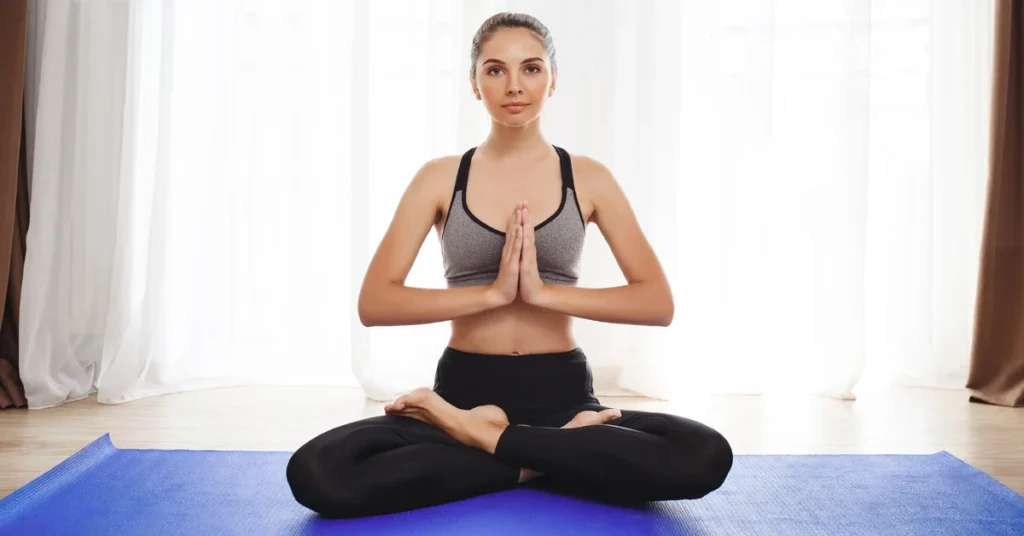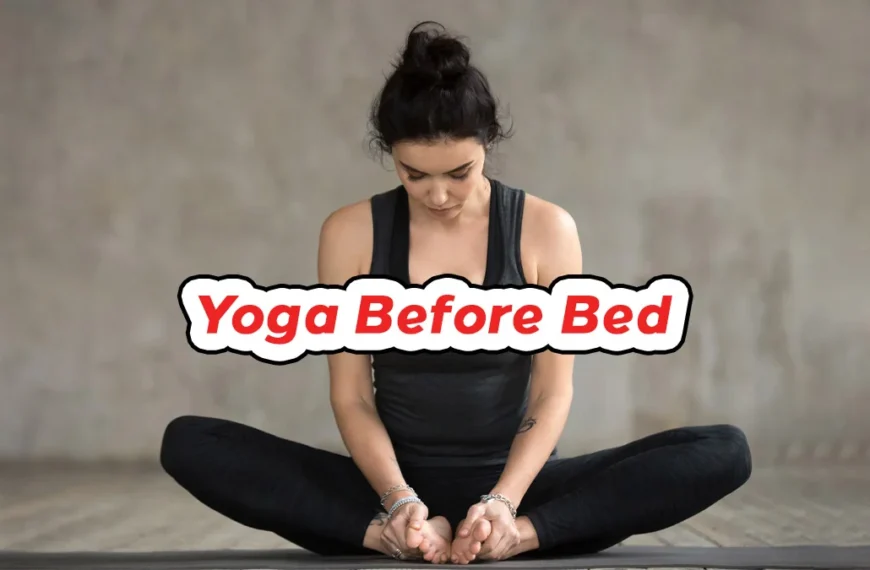“Balance Your Hormones Naturally: Discover the Power of Yoga for Hormonal Imbalance. Explore effective yoga practices to restore hormonal harmony in your body.”

Introduction:
At the heart of our well-being lie hormones, which are drivers of bodily functions related to energy levels, metabolism, mood regulation, digestion, growth and reproductive processes. The complex balance of these hormones is vital to our overall health. Disruptions or irregularities in this delicate balance can manifest as a number of health concerns, including obesity, PCOS and thyroid disorders. Remarkably, many of these hormonal challenges find their origins in our lifestyle choices.
While the inclination may be towards corrective pills, the path to real change and reconciliation often involves adopting traditional and holistic methods. Enter Yoga – a time-tested Indian tradition that has served as a panacea for various health ailments for generations. Through a series of purposeful asanas and a consistent routine, yoga extends its therapeutic touch to both the inner and outer dimensions of our well-being.
Here’s how Yoga Helps in Hormonal Imbalance:
Certain yoga postures are like a gentle wake-up call for the whole body, helping it to function properly. This teamwork ensures that hormones are constantly being made and distributed throughout the body, keeping things running smoothly.
Breathing is like a secret code that unlocks the best elements of our body. Yoga’s method of focusing on the breath is not only good for the lungs, but it’s also a high-five for the hormone control center. This ensures that the Control Center operates like a well-oiled machine.
Stress is like a secret troubleshooter for hormones. But yoga has its own superhero way of busting stress. Science agrees – studies show that yoga helps relieve stress. To make it even more powerful, adding special breathing (pranayama) and quiet time (meditation) to your yoga routine can be like giving it extra power.
Pro Tip: Still, practicing yoga without a plan may not yield the desired results. On the other hand, targeted postures can significantly enhance your ability to regain physical balance.
Here are Some Effective Yoga Poses For Hormonal Imbalance:
Balasana or Child’s Pose:
Balasana, often referred to as child’s pose, plays an important role in nurturing organ health and facilitating hormone regulation. Through smooth limb flexibility, it helps maintain their vitality and proper hormonal secretion. This asana acts as a complete relaxation technique, gently stretching the tendons and releasing tension from the body. Specifically, lengthening the spine through this pose helps reduce back pain and improve posture.
- To begin, sit on your heels in a comfortable position.
- Slowly come to hands and knees position, making sure your arms and legs are parallel, though not too spread apart.
- Take a deep breath.
- Exhale slowly and bend your hips back to rest them on your heels.
- Tilt your forehead to the floor.
- Position your arms in two ways: either extend them straight out on the floor in front of you, or gently align them with your body, palms facing up.
- Allow your muscles to relax and take deep, conscious breaths.
Baddha Konasana or Cobbler Pose:
Mochi pose, better known as Baddha Konasana, is an effective yoga pose to address hormonal imbalance in women by promoting menstrual health. This pose contributes to enhancing glandular function, with a special focus on the prostate gland, which actively supports ovulation and bladder regulation.
- Begin by sitting on the mat with your knees bent and close to each other.
- Slowly encourage your knees to open outward, so that the soles of your feet meet in the middle.
- Place your thumbs between the soles of your feet, interlocking them.
- Rest your elbows on your thighs.
- Gently lean forward while guiding yourself toward your feet.
- Stop at the point where your body naturally tells you to stop, maintaining the position.
- Slowly return to the upright posture and repeat the sequence as desired.
ALSO READ: What are the health benefits of eating a variety of fruits and vegetables?
Ustrasana or Camel Pose:
Beginning this pose, Camel Stance acts as a comprehensive muscle stretch, helping to release accumulated tension. Its benefits extend to refining both the respiratory and lymphatic systems. Particularly noteworthy is its ability to provide relief to individuals suffering from thyroid problems, diabetes, spondylitis and asthma.
- To begin with, assume a kneeling position on a mat.
- Keep your feet at a comfortable distance from each other.
- Take a deep breath to prepare.
- As you exhale, gently push your hips forward and arch your back.
- Slowly lower your hands down to reach your ankles.
- Allow your head to gently tilt back, promoting relaxation.
- Maintain this posture for a while focusing on your breath.
- Return to the squatting position, Vajrasana.
- Repeat the sequence as desired, embracing the rejuvenating effects of Camel Stance.
Ardha Chandrasana or Half Moon Pose:
Ardhachandrasana, or Half Moon Pose, is like a superhero for your legs. It strengthens your ankles, knees and feet. If you have back pain, this pose can help with that as well. It’s also great for your chest and shoulders, making them work better.
- Stand on the mat with your feet apart, as if you were forming a large triangle.
- Turn your right foot to the right so that your toes point to the same side.
- Look to your right.
- Raise and spread both your hands. One hand moves forward, following the toes of your right foot, while the other hand moves back to the left.
- Slowly bend to the side from your waist and try to touch your right ankle with your right hand.
- Adjust your feet so that you feel comfortable and stable.
- Raise your left hand up towards the sky.
- Look at your raised hand and take a few deep breaths.
Sasangasana or Rabbit Pose:
Rabbit pose is like a superhero for your nose and throat. If you have a sore throat or a blocked nose, this pose may help you feel better. This is great if you have trouble sleeping and want to boost your metabolism.
- Let’s start with Child’s pose.
- Gently hold your ankles with your hands.
- Take your forehead closer to your knees.
- Keep the upper part of your head on the mat as if you are resting it.
- Remember to breathe normally.
- Hold tight to your ankles.
- Breathe in and lift your hips towards the sky.
- Try balancing on the top of your head.
- Slowly bring your forehead as close to your knees as possible.
- Keep breathing in peace.
- Stay in this posture for a while, about 30 to 60 seconds.
- When you’re done, exhale and come back to child’s pose.
Prasarita Padottanasana or Wide Stance Pose:
This yoga asana strengthens your back, abdominal muscles and legs. It also helps you feel less stressed and anxious, and it improves your blood circulation. When your blood flows well, your hormones work better too.
- Stand on your mat with your feet apart.
- Turn your toes in slightly to get a better grip on the mat.
- Take a deep breath in.
- Exhale as you bend your body forward, turning yourself towards the ground.
- Place your hands on the mat in front of you.
- Stay still and take a few deep breaths.
Masalasana or Garland Pose:
Masalasana is like a superhero for digestion. When you have PCOS, you may feel upset, bloated or even in pain. But doing masalasana can help your stomach feel better. It also strengthens your core and reduces stiffness in your hips, which can prevent pain and discomfort.
- Stand on your mat with your feet apart.
- Squat Down: Slowly lower yourself down until you are in a squat position.
- Tuck your elbows inside your knees.
- Bring your hands together as if you are saying “hi”.
- While in this position, take a few breaths.
Shalabhasana or Locust Pose:
Shalabhasana is one such pose which helps in strengthening your abdominal muscles. It’s like giving your abs a little workout. It is also good if you have back pain or a slipped disc in your spine.
- Lie down on the stomach on the mat.
- Extend your arms behind you, keeping your palms facing the floor.
- Turn your toes so they point outward, and spread your legs.
- Lift your head, chest, thighs and feet off the mat.
- Raise and spread your hands off the mat.
- Stay in this position and take a few breaths.
- Lower yourself back down and relax.
Setubandhasan or Bridge Pose:
Setubandhasana is a pose that is like a comforting hug for your brain and nerves. It may help you feel less anxious or depressed. Plus, it makes you feel better all around. This asana is also great for your chest, neck and spine.
- Lie on your back on the floor.
- Bend your knees and keep your feet slightly apart.
- Place your hands on the floor with your hands towards your feet.
- Take a big breath and lift your hips up, creating a small bridge shape with your body.
- Relax your muscles and stay in this position for some time.
- Slowly bring your knees back down and do the same posture again.
ALSO READ: Root Vegetables That Help with Quick Weight Loss
Bhujangasana or Cobra Pose:
The cobra pose is an easy and super helpful pose. It’s like giving your chest and lungs extra room to breathe. Doing this pose more often makes your lungs even stronger.
- Lie on your tummy on the yoga mat.
- Put your hands under your shoulders, like you’re getting ready for a push-up.
- Keep your feet close together, with your toes pointing out.
- Slowly lift your chest and the top part of your body off the mat. Look up towards the sky.
- Stay in this position and take a few breaths.
- Gently lower yourself back down and relax your arms and legs.
- Repeat all these steps.
Frequently Asked Questions (FAQ’s)
What is the best way to balance female hormones?
The best way to balance female hormones is through consistent yoga practice to promote hormonal harmony. Engaging in specific postures and techniques can effectively support this balance. Restorative asanas such as “Supta Baddha Konasana” and “Viparita Karani” provide relaxation, while twists such as “Bhardvajasana” stimulate the abdominal organs associated with hormone regulation. Back bending and forward bending have effects on the endocrine system and stress response. Incorporating meditation, pranayama and yoga nidra can reduce stress. Adopting a holistic lifestyle along with these practices can optimize the pursuit of hormonal balance.
How do I stop my hormonal imbalance? OR How can I increase my hormonal balance?
- Healthy diet: Eat a balanced diet rich in whole foods, lean proteins, healthy fats, and a variety of fruits and vegetables. Avoid excessive sugar and processed foods.
- Regular exercise: Engage in regular physical activity such as cardio, strength training, and yoga. Exercise helps regulate hormones and manage stress.
- Adequate Sleep: Prioritize quality sleep, aim for 7-9 hours each night. A consistent sleep schedule supports hormonal regulation.
- Stress management: Try ways to reduce stress, such as meditation, deep breathing, and mindfulness. Chronic stress can disrupt hormone balance.
- Limit caffeine and alcohol: Reduce your intake of caffeine and alcohol, as excessive intake can affect hormone levels.
- Stay hydrated: Be sure to drink enough water each day to help your body function well, including keeping hormones balanced.
- Avoid harmful chemicals: Minimize your exposure to endocrine-disrupting chemicals found in some plastics, cosmetics, and household products.
- Herbal supplements: Some herbal supplements such as chasteberry, maca, and ashwagandha are believed to support hormonal balance. Consult a health care professional before trying any new supplement.
- Medical Evaluation: If symptoms persist or worsen, consult a healthcare provider. They can perform tests to identify the specific hormonal imbalance and recommend appropriate treatment options.
- Lifestyle Adjustments: Listen to your body and make necessary lifestyle adjustments. Everyone’s hormonal balance is unique, so tailor your approach to what works best for you.
Can yoga cure hormonal imbalance?
Yoga can help manage and rectify hormonal imbalances, but it cannot cure them completely. Regular yoga practice can aid in hormone regulation, reduce stress and promote overall well-being. However, effectiveness may vary from person to person, and severe hormonal imbalances may require additional medical treatment. It is best to use yoga as a complementary approach along with medical guidance for a holistic approach towards health.
Which yoga is best for hormonal imbalance?
Achieving hormonal balance is most effectively done by maintaining a regular yoga practice that encourages harmony among female hormones. In this blog, we have already discussed about some yoga asanas which help in rectifying the hormonal imbalance in our body. Please take a look at each of them.
What exercises improve hormonal balance?
Certain exercises can help increase the levels of important hormones in your body. It’s great to do intense exercises like squats, lunges, pull-ups, crunches, and pushups. Try to keep your rest periods short between exercises. When you work out really hard, your body releases more of these supportive hormones.
“Good news! Te Mend is now available on WhatsApp & Telegram Channels. Subscribe today through the link and stay updated with the latest news!” Whatsapp & Telegram




